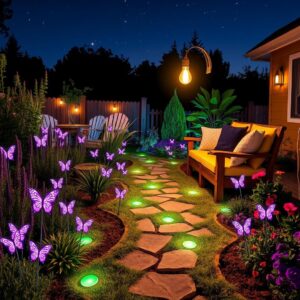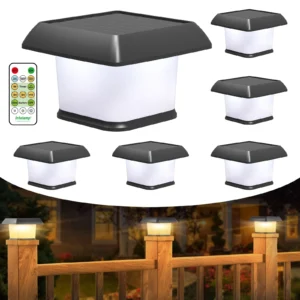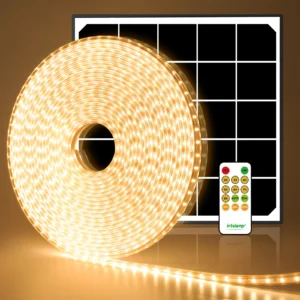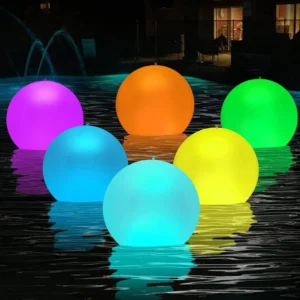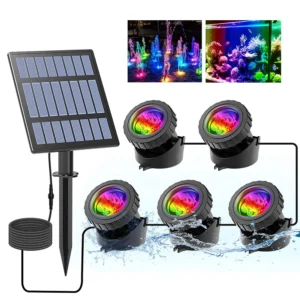When choosing solar lights, many individuals wonder: Should I select a 50W, 100W, or other wattage? Understanding how to choose solar lights requires more than just looking at wattage.
How Solar Lights Operate
Solar lights function by harnessing solar energy, which involves a well-coordinated system of components. Understanding this operation is crucial for anyone looking to choose solar lights effectively.
The Role of Solar Panels
At the heart of solar lights are solar panels, which are made up of photovoltaic (PV) cells. These cells absorb sunlight and convert it into direct current (DC) electricity. The efficiency of solar panels varies based on their materials and design, affecting how much energy they can generate. The better the solar panel output, the faster the battery can charge.
Energy Storage in Batteries
Once the solar panels convert sunlight into electricity, this energy is stored in batteries for later use. Most solar lights use lithium-ion batteries, such as the common 18650 model, which typically operate at around 3.7 volts. The battery capacity—measured in amp-hours (Ah)—indicates how much energy the battery can store, directly impacting how long the solar light can operate when the sun isn’t shining.
Powering LED Lights
When dusk falls, the stored energy is released to power LED lights. LEDs are highly efficient and consume less power than traditional incandescent bulbs, providing brighter illumination with lower energy usage. The brightness of the LED lights is often specified in lumens, which measures the total amount of visible light emitted. Thus, when selecting solar lights, considering both wattage and LED brightness is essential.
Controllers and Sensors
Solar lights also incorporate controllers, which manage the flow of electricity from the batteries to the LEDs. These controllers ensure that the lights operate efficiently, turning on automatically at dusk and off at dawn. Some advanced solar lights feature motion sensors that activate the lights only when movement is detected, conserving battery power and extending operational time.
The Importance of Quality Components
The performance of solar lights greatly depends on the quality of each component—solar panels, batteries, LEDs, and controllers. A well-designed solar light system will optimize energy capture and usage, ensuring reliable operation throughout the night. It’s important to look for reputable brands that provide detailed specifications on each of these elements to make an informed choice.
Comparing Solar Lights to Other Electrical Devices
When selecting solar lights, it can be helpful to compare them to familiar electrical devices such as electric vehicles, smartphones, and traditional lighting systems. This comparison sheds light on the unique characteristics and considerations of solar technology.
Battery Dependence
Like electric vehicles and smartphones, solar lights rely on batteries to store energy for operation. Electric vehicles use large battery packs to power electric motors, while smartphones depend on compact batteries for their myriad functions. Similarly, solar lights store solar energy in batteries, typically lithium-ion models like the 18650, which dictate how long the lights can operate after sunset.
However, the emphasis on battery capacity varies among these devices. While electric cars often highlight range and battery size, solar lights tend to focus more on wattage and lumens, which can be misleading. Understanding that solar light performance is closely linked to battery capacity is crucial for making an informed choice.
Wattage and Performance Metrics
In conventional electrical devices, wattage often indicates performance and energy consumption. For example, a higher wattage in incandescent bulbs correlates with greater brightness. However, in the solar lighting industry, wattage can be a less reliable indicator of performance due to the complexities of solar technology.
Solar lights may be labeled with wattage that reflects the total output of the LEDs but does not account for the limitations of the battery. Unlike traditional devices, which can easily be compared by wattage, solar lights require a deeper understanding of their components to assess their true capabilities.
Standardization Issues
In traditional electrical devices, standards are more uniform. For instance, a 60W incandescent bulb will consistently produce a certain brightness. In contrast, the solar lighting industry lacks clear standardization, leading manufacturers to use varied metrics for assessing output. This can create confusion for consumers who expect a straightforward comparison based on wattage alone.
The Influence of Solar Technology
Solar lights are distinct because they rely on renewable energy, making them more environmentally friendly than traditional electric lights. This reliance on solar energy introduces factors such as geographic location, weather conditions, and seasonal changes, which can significantly impact performance. Electric vehicles and smartphones are less affected by these variables, as they operate on a consistent electricity supply.
Practical Applications
Understanding these differences can guide users in selecting solar lights for specific applications. For instance, while a smartphone is designed for portability and multifunctionality, solar lights are geared towards outdoor use, requiring considerations of weather resistance, battery longevity, and installation convenience.
Wattage and Its Importance in Solar Lights
Wattage is a common term used to describe the power consumption of electrical devices, and it plays a crucial role in the solar lighting industry. Understanding wattage in the context of solar lights can help consumers make better-informed decisions when choosing the right product for their needs.
Understanding Wattage in Solar Lighting
In solar lights, wattage typically refers to the amount of power the LEDs can consume or produce. For example, a solar light may be advertised as having a 30W output, indicating the total power drawn by the LEDs when operating at full capacity. However, this measurement can be misleading due to the unique characteristics of solar technology.
The Role of Solar Panel Output
The wattage of a solar light does not solely determine its performance; it is also closely tied to the solar panel output. A solar panel’s efficiency in converting sunlight into electricity is critical for charging the battery. If a solar panel cannot generate enough energy to support the wattage of the LEDs, the light may not function optimally, leading to reduced brightness or shorter operating times.
LED Efficiency and Brightness
When discussing wattage in solar lights, it is important to consider the efficiency of the LEDs themselves. LED technology is designed to provide more light per watt compared to traditional incandescent bulbs. For instance, a 10W LED light can produce the same brightness as a 60W incandescent bulb, making LEDs a more efficient choice for solar applications.
Misconceptions About Wattage
One common misconception is that higher wattage always equates to better performance. While higher wattage can indicate increased brightness, it does not necessarily mean that a solar light will function effectively. For example, a solar light rated at 30W may sound impressive, but if the battery capacity is low or the solar panel output is insufficient, the actual brightness and duration of use could be far less than expected.
Variability and Lack of Standards
The solar lighting industry currently lacks standardized methods for rating wattage, leading to discrepancies among manufacturers. This lack of consistency can create confusion for consumers who attempt to compare products. For example, a solar light with 30W output may not perform the same as another with a similar rating due to differences in battery technology, solar panel quality, and overall design.
Factors Beyond Wattage
To choose the right solar light, it’s essential to look beyond wattage alone. Considerations such as solar panel output, battery capacity, LED quality, and system controllers play significant roles in determining the overall performance of a solar light. A holistic approach that evaluates all these factors will lead to a more satisfying purchase.
Factors to Consider When Choosing Solar Lights
Selecting the right solar lights involves evaluating several key factors beyond just wattage. Understanding these components will ensure that you choose a system that meets your specific lighting needs and performs reliably. Here are the most critical factors to consider:
1. Solar Panel Output
The output of the solar panel is crucial, as it determines how effectively the system can convert sunlight into electricity. A solar panel with a higher output can charge the battery more quickly and efficiently. Look for panels that are made from high-quality materials, such as monocrystalline or polycrystalline silicon, as they typically offer better efficiency and longevity.
- Tip: Check the panel’s wattage rating and efficiency percentage. Higher efficiency ratings mean more energy conversion, especially in low-light conditions.
2. Battery Capacity
Battery capacity is another vital factor to consider. It determines how long the solar light can operate once fully charged. Capacity is usually measured in amp-hours (Ah) or watt-hours (Wh). A larger battery capacity allows for longer usage times, especially during cloudy days or winter months when sunlight may be limited.
- Tip: Look for lights with lithium-ion batteries, as they generally offer better performance and longevity compared to older battery types.
3. LED Brightness
The brightness of the LEDs used in solar lights is expressed in lumens. A higher lumen rating indicates brighter light output. When choosing solar lights, consider the specific application: for pathways, lower lumens may suffice, while areas requiring more illumination, such as security lighting, will benefit from higher lumens.
- Tip: Compare lumen ratings across different models to find the best fit for your lighting needs.
4. System Controller
The system controller is responsible for managing the flow of electricity between the solar panel, battery, and LEDs. It ensures the lights turn on and off automatically at dusk and dawn and may also include features like motion sensors to conserve energy.
- Tip: Look for systems with advanced controllers that offer programmable settings or smart features for greater control over the lighting schedule.
5. Durability and Weather Resistance
Since solar lights are typically used outdoors, they must be durable and weather-resistant. Check the materials used in construction and ensure they can withstand various environmental conditions, including rain, snow, and extreme temperatures. Look for lights with an IP (Ingress Protection) rating, which indicates resistance to dust and water.
- Tip: A higher IP rating (e.g., IP65 or IP67) signifies better protection against water and dust.
6. Installation and Maintenance
Consider the installation process and any ongoing maintenance requirements. Some solar lights are easy to install with no wiring needed, while others may require more complex setups. Additionally, assess whether the lights need regular maintenance, such as cleaning solar panels or replacing batteries.
- Tip: Choose models with minimal maintenance needs for convenience, especially if they will be installed in hard-to-reach locations.
7. Design and Aesthetics
While functionality is crucial, the design and aesthetics of solar lights should also match your outdoor decor. Solar lights come in various styles and finishes, from modern to traditional. Consider how the lights will complement your landscape and enhance your outdoor spaces.
- Tip: Select designs that not only provide the necessary illumination but also add to the visual appeal of your outdoor area.
8. Brand Reputation and Warranty
Finally, consider the reputation of the manufacturer and the warranty offered. Established brands are often more reliable and provide better customer service and support. A good warranty can give you peace of mind regarding the quality and longevity of your investment.
- Tip: Research customer reviews and ratings to gauge the performance and reliability of the brand.
Conclusion
When choosing solar lights, consider all relevant factors to find the best fit for your needs. By evaluating solar panel output, battery capacity, and LED brightness, you can ensure you select the right solar light for your environment.


